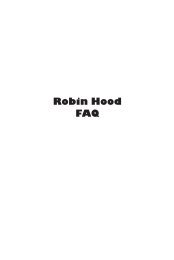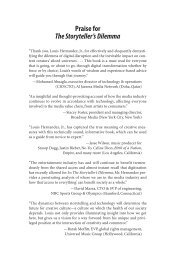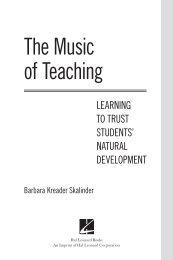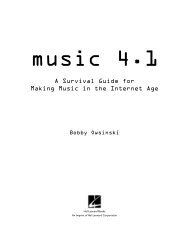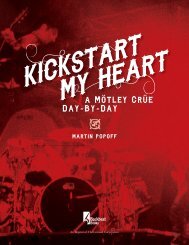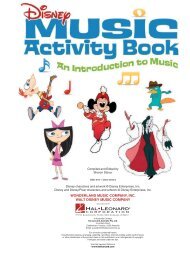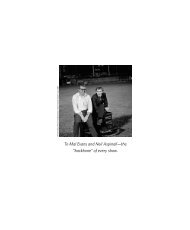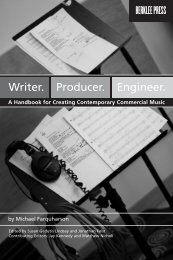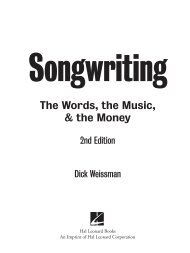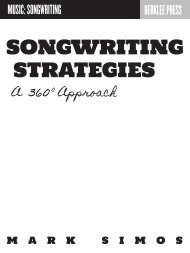You also want an ePaper? Increase the reach of your titles
YUMPU automatically turns print PDFs into web optimized ePapers that Google loves.
<strong>How</strong> <strong>to</strong> <strong>Have</strong> <strong>Your</strong><br />
<strong>Hit</strong> <strong>Song</strong> <strong>Published</strong><br />
Jay Warner<br />
<strong>Revised</strong> and <strong>Updated</strong> Edition
Copyright © 1978, 1980, 1988, 2006 by Jay Warner<br />
All rights reserved. No part of this publication may be reproduced or transmitted<br />
in any form or by any means, electronic or mechanical, including pho<strong>to</strong>copy,<br />
recording or any other information s<strong>to</strong>rage or retrieval system now known or <strong>to</strong> be<br />
invented, without permission in writing from the publishers, except by a reviewer<br />
who wishes <strong>to</strong> quote brief passages in connection with a review written for inclusion<br />
in a magazine, newspaper, or broadcast.<br />
References <strong>to</strong> Internet Web sites (URLs) were accurate at the time of writing.<br />
Neither the author nor Hal Leonard is responsible for URLs that may have expired<br />
or changed since the manuscript was prepared.<br />
Jacket design by Kristi Montague.<br />
Book interior by Snow Creative Services.<br />
<strong>Published</strong> by Hal Leonard Corporation<br />
7777 Bluemound Road<br />
P.O. Box 13819<br />
Milwaukee, WI 53213<br />
Trade Book Division Edi<strong>to</strong>rial Offices<br />
19 West 21st Street<br />
Suite 201<br />
New York, New York 10010<br />
Library of Congress Cataloging-in-Publication Data<br />
Warner, Jay.<br />
<strong>How</strong> <strong>to</strong> have your hit song published / Jay Warner. – 4th ed., updated and rev.<br />
p. cm.<br />
Includes index.<br />
ISBN-13: 978-1-4234-1199-4<br />
ISBN-10: 1-4234-1199-4<br />
1. Popular music—Writing and publishing. I. Title.<br />
MT67.W26 2006<br />
070.5’794—dc22<br />
2006026157<br />
Printed in the United States of America<br />
Fourth Edition<br />
Hal Leonard books are available at your local books<strong>to</strong>re, or you may order through<br />
Music Dispatch at 1-800-637-2852 or www.musicdispatch.com.
Contents<br />
Foreword<br />
Introduction<br />
ix<br />
xi<br />
Chapter 1 A General His<strong>to</strong>ry of Publishing in America 1<br />
Chapter 2 What Is Publication? 7<br />
Chapter 3 Copyrights, Copyrighting, and You 11<br />
Chapter 4<br />
Performing Rights Societies: When and Why You<br />
Need Them 23<br />
Chapter 5 <strong>How</strong> <strong>to</strong> Choose a Performing Rights Society 29<br />
Chapter 6 The Current Copyright Law 47<br />
Chapter 7 <strong>How</strong> <strong>to</strong> Present <strong>Your</strong> <strong>Song</strong> 59<br />
Chapter 8 <strong>How</strong> <strong>to</strong> Pick a Publishing Company 83<br />
Chapter 9 <strong>How</strong> a Publishing Company Works 91<br />
Chapter 10 <strong>How</strong> <strong>to</strong> Make Publishing Contacts 107<br />
Chapter 11 <strong>How</strong> <strong>to</strong> Run <strong>Your</strong> Own <strong>Song</strong>s 129<br />
Chapter 12 <strong>How</strong> <strong>to</strong> Publish <strong>Your</strong> Own <strong>Song</strong>s 149<br />
Chapter 13 Basic <strong>Song</strong>writer Agreements and Licenses 173<br />
Chapter 14 Different Types of Publishing Deals 217<br />
Chapter 15 Subpublishing, Foreign Markets, and <strong>Your</strong> <strong>Song</strong>s 245<br />
Chapter 16 Writer and Publisher Industry Problems and Challenges 267<br />
Chapter 17 New Technologies and Their Effects on the <strong>Song</strong>writer 283<br />
A Final Note 297
viii<br />
Contents<br />
Appendices<br />
I Music Publishers 299<br />
II <strong>Song</strong>writer Showcases 307<br />
III Licensing Societies 309<br />
IV Record Companies 311<br />
V Producers, Engineers, Mixers 323<br />
VI Record Distribu<strong>to</strong>rs 337<br />
VII Music Industry At<strong>to</strong>rneys 339<br />
VIII Music Supervisors 353<br />
IX Film/TV Music Departments and Supervisors 357<br />
X <strong>Song</strong>writer Associations — Domestic and Foreign 361<br />
XI Music Libraries 365<br />
XII International Subpublishers 371<br />
Glossary 385<br />
References 389<br />
Index 391<br />
About the Author 399
Introduction<br />
When I wrote the first edition of this work, I was a wide-eyed, twentysomething<br />
adventure-seeking music publisher who’d convinced his boss,<br />
the legendary Wes Farrell, that he needed me more in California then in<br />
my frozen wasteland homeland, New York City.<br />
I accomplished this through no great strategy on my own, but by a quirk<br />
of Big Apple fate. We walked down Broadway <strong>to</strong>gether in the winter of<br />
1976 and a gust of wind <strong>to</strong>ok me (on three bounces) from West 46th Street<br />
<strong>to</strong> nearly the end of West 45th Street, where I ducked in<strong>to</strong> a s<strong>to</strong>refront with<br />
visions of being blown in<strong>to</strong> traffic, thus depriving Wes of his professional<br />
manager. About a minute later the six-foot, handsome “boy wonder” (as the<br />
business referred <strong>to</strong> him), who could charm the skirt off a nun, sauntered<br />
by, laughing at my flight down the Great White Way. I was embarrassed<br />
and indignant at his reaction, but my own, though now fateful and his<strong>to</strong>ric<br />
in my mind, was at the time a mindless rant of “Okay, laughing boy<br />
wonder, move me <strong>to</strong> L.A. or I’m quitting!” Immediately I thought, “You just<br />
killed your career because you can’t handle a New York wind.” But Wes just<br />
laughed and said, “You really want <strong>to</strong> come <strong>to</strong> La-La Land? Sure, I can use<br />
you out there.”<br />
Within four months (May 1976), Farrell had kept his promise and I<br />
was actually living on the left coast. I recount this tale because I firmly<br />
believe this book never would have been written if I hadn’t moved <strong>to</strong> Los<br />
Angeles. The rock ’n’ roll scene was still vibrant out West. L.A. was magical<br />
<strong>to</strong> a lifelong New Yorker and what they called a s<strong>to</strong>rm here was basically<br />
a drizzle in Brooklyn. I thought, “All things are possible here,” although I<br />
couldn’t imagine at the time what was <strong>to</strong> come. I spent the next year not<br />
only working our catalog of songs, but learning as much as I could about<br />
the inner workings of publishing, licensing, copyrights, the law, and how <strong>to</strong><br />
build and maintain relations with writers.<br />
This wasn’t an easy thing in the pre-Internet Age, where books on the<br />
subject were nonexistent and I found that the business’s very nature was<br />
that of a cornucopia of hidden secrets. In other words, publishers didn’t<br />
like <strong>to</strong> let the public, or even the artists and writers, know the behind the<br />
scenes activities of this seemingly mundane, but actually “gold in them<br />
there copyrights” industry. I remember thinking, “God, we’re the actuaries
xii<br />
<strong>How</strong> <strong>to</strong> <strong>Have</strong> <strong>Your</strong> <strong>Hit</strong> <strong>Song</strong> <strong>Published</strong><br />
of entertainment.” Soon I realized that the only way <strong>to</strong> really learn this<br />
business in the ’70s was <strong>to</strong> be in the business and learn from the contacts<br />
and experiences one garners while doing the day-<strong>to</strong>-day routine. I especially<br />
queried pros in publishing at every chance, kept extensive logs on<br />
meetings and began formalizing more simplified methods of getting as<br />
many songs <strong>to</strong> prospective producers, artists, and managers as possible.<br />
Lest you think at this point that this was strictly for a noble purpose<br />
and the fulfillment acquiring knowledge brings, it was also for survival as<br />
I felt the more I was indispensable <strong>to</strong> my company the less likely <strong>to</strong> find<br />
myself unemployed in a strange land.<br />
The day of destiny arrived in early 1977. Wes brought me in<strong>to</strong> a meeting<br />
with two producers who we were negotiating with for their act. Also in<br />
the meeting was one of Farrell’s executives, Joe Smit. While Wes charmed<br />
them in<strong>to</strong> the comfort zone of confidence that we were the best record<br />
machine since Mo<strong>to</strong>wn Records, I was there <strong>to</strong> convince them that we<br />
would be a great promoter of their songs.<br />
When the meeting was over I walked down the hall with Smit behind<br />
me. He walked in my office and smiled. I said, “What?” and he responded,<br />
“You really covered the bases. They were knocked out. You ought <strong>to</strong> write<br />
a book!” I said, “Yeah, right, I haven’t got enough <strong>to</strong> do here. All I did was<br />
give myself a lot more work for the company.” He answered coyly, “So<br />
you’re saying you can’t write a book on publishing, huh?” Well, Brooklyn<br />
boys grow up <strong>to</strong> be suckers for a dare, and this confident newcomer was no<br />
exception.<br />
I said, “I could write a book if I wanted <strong>to</strong> but I just don’t have the time.”<br />
Joe kept at me off and on for a few months and slowly, I started putting<br />
<strong>to</strong>gether ideas on how I’d do what hadn’t ever been done except for highly<br />
complex papers written by lawyers on copyright law. If I was going <strong>to</strong> do<br />
this, I reasoned, I certainly wasn’t going <strong>to</strong> let anyone know until I was sure<br />
I wouldn’t fall on my face.<br />
I decided that I should use not being an entertainment lawyer <strong>to</strong> my<br />
advantage. The book would have <strong>to</strong> be written by a publisher with a songwriting<br />
mentality in layman’s terms and its niche would be a work for<br />
the masses, easy <strong>to</strong> understand, and practical with charts, diagrams, lists<br />
of contacts, forms, simplified royalty flow charts, maps of the key music<br />
meccas and where the companies were, form contracts, and explanations<br />
paragraph by paragraph, etc. It was really intended <strong>to</strong> be a primer on what<br />
<strong>to</strong> do with your songs after you wrote them. I rationalized, I’ll leave it <strong>to</strong><br />
others <strong>to</strong> teach them how <strong>to</strong> write a hit song.<br />
By the spring, Joe <strong>to</strong>ld me he and his wife were moving <strong>to</strong> the country,<br />
something he’d always wanted <strong>to</strong> do and he was going <strong>to</strong> set up his own<br />
book publishing company. Well, you know where that led and, in 1978, the
Introduction<br />
xiii<br />
first edition of <strong>How</strong> <strong>to</strong> <strong>Have</strong> <strong>Your</strong> <strong>Hit</strong> <strong>Song</strong> <strong>Published</strong> came out complete<br />
with a front cover pho<strong>to</strong> of what was laughingly referred <strong>to</strong> by the staff as<br />
“the War Zone,” actually my office desk piled high with papers, licenses,<br />
tapes, records, acetates, sheet music, and charts. I wanted <strong>to</strong> clean it up,<br />
but Joe felt the mass was indicative of what it was <strong>to</strong> be a real publisher,<br />
someone who wears numerous hats in a quest <strong>to</strong> find and exploit the next<br />
Bruce Springsteen or the next “Blinded by the Light.”<br />
Twenty-eight consecutive years in print later and now in its fourth edition<br />
I’m proud and pleased that both the book and I have gotten this far.<br />
I guess you should never underestimate the power of simplicity.
CHAPTER<br />
4<br />
Performing Rights Societies:<br />
When and Why You Need Them<br />
Public performance royalties of recorded music are the greatest source<br />
of income in the music industry. These performance royalties are<br />
based on a percentage scale and are collected by BMI, ASCAP, and<br />
SESAC, the three major collection agencies in the United States. Writers in<br />
the U.S. must belong <strong>to</strong> one (and only one) of these agencies in order <strong>to</strong> collect<br />
royalties for airplay of their songs in the United States. Furthermore,<br />
these licensing organizations are set up (either through affiliates or companies<br />
with whom they have a licensing agreement) <strong>to</strong> collect royalties on<br />
airplay outside the United States. The U.S. Congress came up with its first<br />
statute covering royalty payment in 1897, but this had little bearing on<br />
songwriters’ income, because copyright owners weren’t organized enough<br />
<strong>to</strong> collect royalties for the use of music from such sources as cabarets and<br />
dance halls.<br />
The following is a short his<strong>to</strong>ry of the Copyright Act and its bearing on<br />
writers and publishers, and how the performing rights societies have been<br />
a guiding force since 1914. The United States Copyright Act of 1909 was a<br />
reasonably good and fair bill for that era, giving American composers, lyricists,<br />
and publishers most of the benefits and protection enjoyed by their<br />
colleagues in other lands. The Act reflected the pre–World War I technology<br />
that affected music performances and delivery of those performances<br />
<strong>to</strong> the public. At that time, there were no radio, television, music systems,<br />
cable TV, satellites, and jukeboxes, let alone the twenty-first-century technologies.<br />
The term of copyright protection, built in<strong>to</strong> the 1909 statute, was<br />
significantly shorter than that of most other countries, but there was little<br />
argument, because America’s crea<strong>to</strong>rs were so glad <strong>to</strong> get copyright protection<br />
for nondramatic performance rights and recording rights. In 1909,<br />
the U.S. got a law, but it still did not get any royalties. No one respected<br />
our performing rights until ASCAP was founded in 1914 by writers and<br />
publishers who organized <strong>to</strong> get the statute enforced.
24 <strong>How</strong> <strong>to</strong> <strong>Have</strong> <strong>Your</strong> <strong>Hit</strong> <strong>Song</strong> <strong>Published</strong><br />
Actually the law was not widely enforced until January 1917, when<br />
the U.S. Supreme Court ruled in ASCAP’s favor in a crucial suit brought<br />
by one of ASCAP’s founding fathers, Vic<strong>to</strong>r Herbert, against Chandley’s<br />
Restaurant in New York. The years passed, the technology changed, and<br />
the world of music evolved, <strong>to</strong> the delight of expanding audiences everywhere.<br />
The statute remained the same, however.<br />
By the 1920s, some members of Congress recognized that the Copyright<br />
Act of 1909 was unrealistic and began <strong>to</strong> discuss changes <strong>to</strong> modernize the<br />
obviously obsolete legislation. Laws were passed <strong>to</strong> remedy economic inequities<br />
affecting larger groups, but composers and lyricists had <strong>to</strong> wait at the<br />
end of the line. The obsolete law survived unchanged; everyone recognized<br />
American music as both a major cultural and economic force, and it was<br />
widely admitted that music was probably our first ambassador internationally.<br />
Technology changed at an ever-increasing rate, but the level of<br />
copyright protection remained frozen in 1909 terms.<br />
Fortunately, the courts first interpreted the old law reasonably and<br />
applied it <strong>to</strong> new uses, particularly <strong>to</strong> radio and television. Later, beginning<br />
in 1968, the trend was reversed when cable television was held exempt. No<br />
one could explain why lyricists, composers, and music publishers should<br />
fall behind or be treated as second-class citizens, but no one could deny<br />
those realities, either.<br />
In 1955, Congress funded a series of studies by the Copyright Office.<br />
It <strong>to</strong>ok nine long years for the first copyright modernization bill of this<br />
generation <strong>to</strong> be introduced. In 1967, the House of Representatives passed<br />
a bill that wasn’t perfect, but which would have done much <strong>to</strong> remedy some<br />
of the major inequities. The Senate never got <strong>to</strong> vote on this bill, and it died.<br />
The effort <strong>to</strong> get a fair bill didn’t die, however. On February 19, 1976,<br />
twenty-one years after the Copyright Office studies were funded by<br />
Congress, fifteen years after they were completed and had demonstrated<br />
the areas in which new legislation was needed, and twelve years after the<br />
first revision bill was introduced, the Senate unanimously passed a bill that<br />
became law on January 1, 1978.<br />
The 1909 law had broad exclusions that limited copyright protection <strong>to</strong><br />
public performances for profit. The new law has removed the “for profit”<br />
limitation and substituted exemptions for specific situations, such as religious<br />
services. The 1909 law created one compulsory license that had long<br />
oppressed crea<strong>to</strong>rs, the proviso that arbitrarily set the recording royalty<br />
for a record at $.02 per record. After sixty-seven years without increase,<br />
Congress raised that rate <strong>to</strong> $.0275.<br />
Anyone familiar with the great rise in living costs since 1909 will<br />
understand why ASCAP and BMI urged a significantly larger increase in<br />
this mechanical rate.
Performing Rights Societies 25<br />
That brings us <strong>to</strong> the present. (For details of the current copyright law,<br />
see chapter 6.) To give you an idea of the growth of performing rights societies,<br />
ASCAP writer membership has gone from 13,500 in 1970 <strong>to</strong> 18,000<br />
in 1977, and <strong>to</strong> 28,000 in 1988. By 2005, ASCAP had a membership association<br />
of more than 148,000 composers, songwriters, and lyricists.<br />
BMI writer membership went up from approximately 10,000 in 1963 <strong>to</strong><br />
over 32,000 in 1977, and 50,000 in 1988. By the mid-1990s, BMI over<strong>to</strong>ok<br />
ASCAP as the society with the most members. As of 2005, BMI represents<br />
more than 300,000 songwriters, composers, and music publishers in all<br />
genres of music.<br />
Publisher membership in both societies has also grown. By 1988,<br />
ASCAP had 10,000 and BMI 30,000 publisher members. Today ASCAP<br />
has more than 80,000 publisher members.<br />
ASCAP has continually increased its collected performance fees, going<br />
from $38 million in 1963 <strong>to</strong> $161 million in 1982, and by 1986 their collection<br />
fees <strong>to</strong>taled over $252 million, more than six times the figures of<br />
1963. In 2004, their performance fees equaled more than $699 million<br />
(before overhead deductions). ASCAP had a 14.9% increase in 2004. Of<br />
ASCAP’s $610 million revenue, over $206 million was from overseas. On<br />
average, ASCAP pays out about $.86 <strong>to</strong> writers and publishers for every<br />
dollar it receives. ASCAP’s overhead is about 13.5% while BMI’s is about<br />
14.5%. In 2005, ASCAP again exceeded its previous revenues for writers<br />
and publishers earning more than $749 million (before overhead deductions).<br />
Domestic revenue reached an all time high of $534.5 million with<br />
international revenue of almost $215 million.<br />
ASCAP’s domestic distribution <strong>to</strong>taled $440.4 million with royalties<br />
from foreign distribution <strong>to</strong>taling $205.5 million. Their overhead reached<br />
an all-time low of 12.5%, reportedly the lowest of any copyright organization<br />
in the world. ASCAP also had a record number of 113 million performances<br />
of musical works In 2005, mostly from land-based radio, satellite<br />
radio, ring<strong>to</strong>nes, the Internet, cable, and local TV, and digital jukeboxes.<br />
BMI’s fiscal 2004–2005 revenues were more than $728 million, an<br />
increase of over 8.3% over the previous year. It was the first time that any<br />
copyright organization in the world had earned over $700 million in a year.<br />
The number was over $56 million more than the previous year. Of the<br />
<strong>to</strong>tal, more than $623 million was distributed <strong>to</strong> publishers, writers, and<br />
composers, an increase of almost $51 million from the previous year. It was<br />
the fifteenth straight year of increasing gross and net royalty payouts.<br />
Adding <strong>to</strong> the growth of the industry, new-media licensing revenues<br />
rose by 114% over the previous year, <strong>to</strong>taling $11.4 million. Revenue from<br />
mobile entertainment (i.e., ring<strong>to</strong>nes) scored the largest increase, almost<br />
190% more than the previous year, at $4 million. Showing a trend away
26 <strong>How</strong> <strong>to</strong> <strong>Have</strong> <strong>Your</strong> <strong>Hit</strong> <strong>Song</strong> <strong>Published</strong><br />
from illegal sources, BMI licensed more than 500 new digital-music providers,<br />
including Sprint PCS, Rhapsody, and Mobzilla. Of the $728 million<br />
gross, more than $202 million came from overseas, while the domestic<br />
general licensing area grew by 12.7% due <strong>to</strong> restaurants, skating rinks,<br />
aerobic and fitness centers, and new contracts with Muzak, the background<br />
music service.<br />
Responding <strong>to</strong> the new technology fields, all three societies have<br />
instituted new licenses for the Internet and mobile phone industries.<br />
ASCAP offers three types of Internet licenses: a noninteractive license<br />
that doesn’t allow downloading, an interactive license that allows music<br />
buyers <strong>to</strong> download, and a third license that authorizes public performance<br />
of songs in wireless devices such as mobile phones. BMI’s main<br />
Internet license type is one where fees are computed on a “gross revenue<br />
calculation” where music is the main feature of the particular site.<br />
SESAC offers a license that provides for payment based on the number of<br />
monthly page requests, as well as the amount of advertising on the site.<br />
Founded in 1930, SESAC, the second-oldest performing rights agency<br />
in the U.S, now boasts that they are the fastest-growing performing rights<br />
agency in America. <strong>How</strong>ever, SESAC does not disclose its numbers of writers,<br />
publishers, or income, and is privately owned, unlike its counterparts<br />
ASCAP and BMI.<br />
Today, performing rights societies collect most of their licensing income<br />
from TV, all forms of radio use of recorded music, and the performance of<br />
music in films in movie theaters overseas. A smaller amount is acquired<br />
by Internet uses, wired-music sources such as Muzak and major concerts,<br />
malls, restaurants, skating rinks, and any public use of licensed music.<br />
As of January 1, 1978, jukeboxes and cable TV were also licensed for use.<br />
Areas long closed <strong>to</strong> publishers and writers are now open, and the new<br />
technologies look <strong>to</strong> be areas of increasing income in the future.<br />
Since performing rights societies were formed primarily <strong>to</strong> provide a<br />
service that individuals could not perform for themselves, including collecting<br />
royalties for writers and publishers as payment for the use of their<br />
music, it is quite obvious why an association with one of these societies<br />
would be <strong>to</strong> the advantage of anyone seriously trying <strong>to</strong> make a go of it as<br />
a writer or publisher. It would be genuinely impossible for individuals <strong>to</strong><br />
negotiate a license as well as moni<strong>to</strong>r their songs use with every possible<br />
user of their copyrighted work(s) in this country, let alone in foreign countries.<br />
Still, the association with these societies is voluntary, not manda<strong>to</strong>ry,<br />
and the time <strong>to</strong> choose joining one is up <strong>to</strong> you.<br />
The most appropriate time <strong>to</strong> join a licensing society is upon (or shortly<br />
after) the actual publication or use of your composition, whether it be<br />
as a record release, film use, TV performance, or concert performance.
Performing Rights Societies 27<br />
The societies do not accept full membership prior <strong>to</strong> publication of a<br />
writer’s first work, as <strong>to</strong>o often dates change or publication or use never<br />
takes effect.<br />
Don’t worry about losing any income credits from these first uses. The<br />
societies are moni<strong>to</strong>ring compositions in a catchall system and are usually<br />
making payment on performances established anywhere from nine months<br />
<strong>to</strong> a year prior <strong>to</strong> their current payment period. For example, if a society<br />
were making payment <strong>to</strong> a writer at the end of the second quarter of 2005<br />
(see chapter 5, “<strong>How</strong> <strong>to</strong> Choose a Performing Rights Society,” for how often<br />
writers are paid), it would be for the airplay or performances logged from a<br />
period usually nine months previous (the third quarter of 2004).<br />
This doesn’t mean, however, that you should wait nine months <strong>to</strong> register<br />
your compositions and yourself as a writer with the society of your<br />
choice. The sooner after publication or use that your representation is in<br />
place, the less likely the opportunity for mistakes <strong>to</strong> arise.





